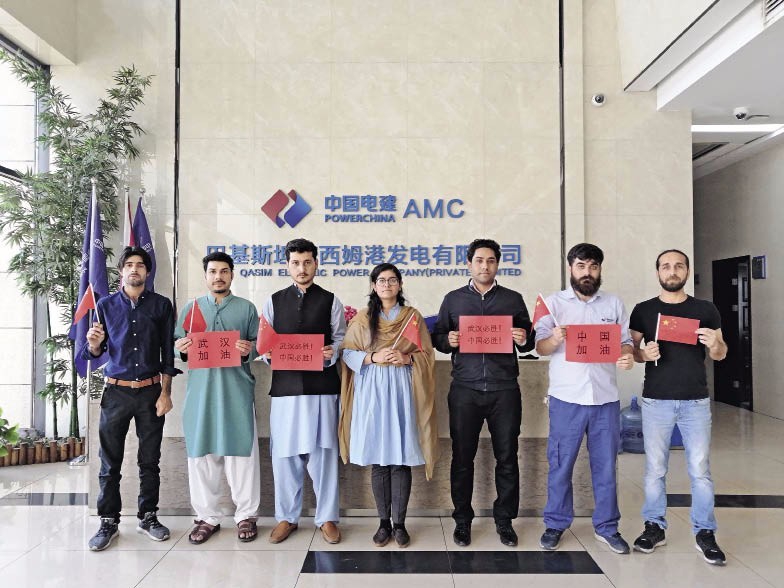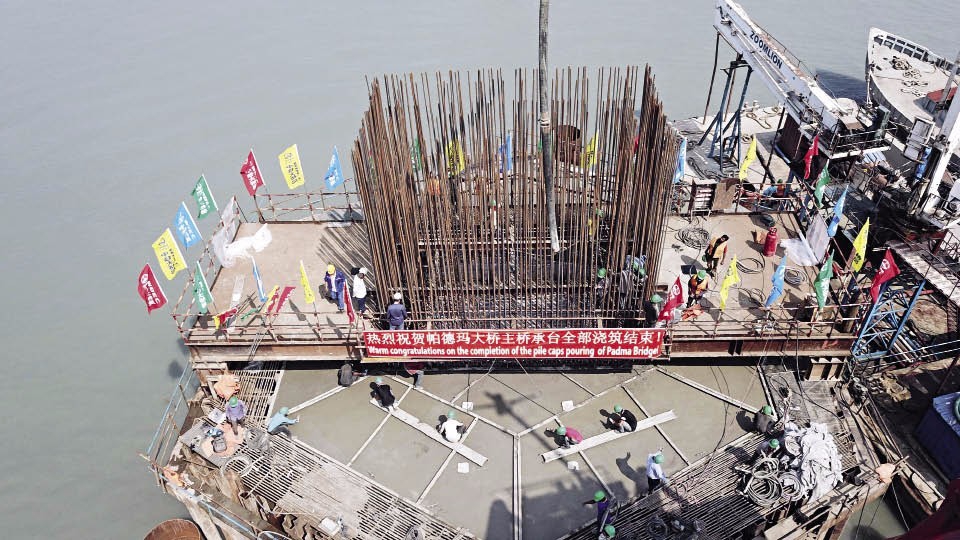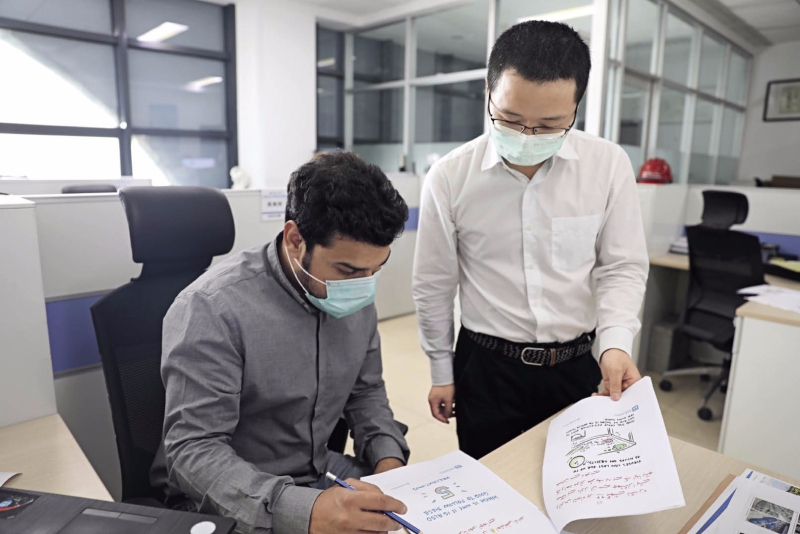
Cloud Working Aids the Dream of Millions
“The much-awaited Padma Bridge is nearing its completion as 86 percent of the construction work of the bridge’s main structure has been completed,” said the project manager Liu Jianhua on March 1. The Padma Bridge, known as “the bridge of dreams” on the outskirts of Bangladesh’s capital Dhaka, is a crucial part of the Padma Bridge Rail Link Project built by China Railway Major Bridge Engineering Group Co., Ltd. (MBEC). With the completion of the pile caps pouring of the Padma Bridge, the construction of the megastructure part below the surface of the water was finished. More than 40 local media outlets covered this milestone event, giving their thumbs up for the Chinese company’s efficient work and the effective anti-virus measures it has taken.
“At the end of 2019, we were told that the electro tower – a subsidiary project of the Padma Bridge – must be finished before the flood season at the end of this April to ensure that the whole bridge would be completed in 2021,” recalled Liu Xiaolin, a chief engineer of the main structure. Liu and his fellows immediately formed a team and devoted themselves to the design drawing of the electro tower. Up till now, Liu’s team has already drafted nearly 15,000 design drawings that follow the widely-adopted international standard.
“It all happened unexpectedly,” Liu said. He recalled that they had returned to Wuhan in January to celebrate the upcoming Spring Festival. However, no one expected that such a rapidly raging epidemic as the novel coronavirus would sweep through the city. A lockdown policy came out on January 23, trapping them at their homes in Wuhan and making them unable to return to Bangladesh. But soon a cloud working team was formed, with everyone busy working online and having meetings with colleagues overseas via iCloud equipment.
Every day, Togbenou Koffi woke up at 8 a.m. and after his daily morning prayers and doing a routine disinfection, he began to work until late at night. The Benin engineer was a doctoral graduate from Southwest Jiaotong University. After graduation in 2018, he joined the design team, drawing the design for reinforcement bars of the cast-in-place layer of the bridge deck for the highway approach bridge. “I have spent this period of time living a simple life, but it has been very meaningful,” said Koffi.

Liu, on the other hand, usually started to focus on his daily work after his son had fallen asleep at night. His wife Tu Hua is an ICU doctor at Hubei Provincial Hospital of Traditional Chinese Medicine. Since January 17, Tu has been working on the frontlines to save lives from the coronavirus and was unable to return home to see him and their son. As a result, Liu had to take over the responsibility of looking after their six-year-old child in addition to leading the design work as well. What Liu’s most proud of is that his team has already finished over 200 design drawings under the extreme circumstances of the epidemic, a guarantee for the smooth construction of the Padma Bridge far away in Bangladesh.
The 169-kilometer-long Padma Bridge Rail Link Project is part of the BRI and is a section of the Bangladesh-China-India-Myanmar Economic Corridor. It is expected to become a transportation hub linking the railways in west and east Bangladesh, thus creating a highly efficient railway network that can largely shorten the distance on land and save time for nationwide transportation. As a result, this will benefit 72 million people and boost local economic growth by 1.5 percent.
Anti-Virus Measures Guarantee Power Supplies
Port Qasim Coal-fired Power Plant constructed by Power Construction Corporation of China Ltd. (POWERCHINA) is a leading energy project under China-Pakistan Economic Corridor in Pakistan and the biggest overseas investment project of POWERCHINA. As of March 29, this power plant had generated a total of 2.2 billion kWh of electricity in 2020, providing a continuous source of energy to more than four million families in Pakistan.
During the novel coronavirus epidemic, Port Qasim Electric Power Company (Private) Limited, an affiliated company of POWERCHINA, has formulated and implemented production safety regulations at all levels, and 14 core coronavirus risk control measures have been taken, including daily disinfection, daily health condition reporting, and personal protective equipment stockpiling. As the epidemic escalated into a pandemic around the world in March, the company has accordingly implemented closed management measures on the project to prevent the spread of the coronavirus.
Shi Pengcheng, a postgraduate from China University of Political Science and Law, was dispatched to Pakistan about one year ago. He said this epidemic has taught him what a real friendship is. “When the epidemic broke out in China, my Pakistani colleagues were always ready to give China a helping hand, and they wrote banners and shot videos to cheer China up. The Pakistani government also provided medical supplies to China.”
Port Qasim Coal-fired Power Plant switched to the “epidemic prevention and control plus safe production” mode immediately after the outbreak of the novel coronavirus. Risk control always takes the first place. Shi joined in the compilation of the Regulations on COVID-19 Prevention and Control. To ensure it is feasible and operational, Shi extensively collected opinions from Pakistan colleagues.
Considering the different living habits, religious beliefs, and cultural diversity, Shi translated the handbook of COVID-19 prevention and control from English into the Urdu together with his Pakistani colleagues. The handbook, containing colorful pictures, was then made into an e-book and broadcast on digital screens for local workers to share with their families and friends.

The company has also strengthened its operation and personnel management, formulated a purchase plan, quantified the daily workload, improved equipment reliability, and guaranteed the unit capacity. More than that, it empowered the role of Pakistani staff as some Chinese workers were unable to return from China after the Spring Festival holiday due to the coronavirus outbreak. At present, the power plant is running at full capacity.
Shagufta Alias Sussee, a postgraduate from the University of Sindh with a major in English, is the first female local staff at the power plant. Her fiancé Farooque Ahmed also works for the power plant as a director of coal transportation and operation management at the port. The young couple had planned to get married in March of this year, but then their plan was disrupted by the epidemic.
The emergency plan was launched at the power plant, and Sussee has become a member of the comprehensive support group. “As some of our Chinese colleagues were unable to come back, there were not enough workers at the coal transportation port to meet the power supply demand, so I must stay.” Ahmed’s decision gained Sussee’s support and they decided to postpone their wedding ceremony, fighting on the frontline together with more than 1,400 colleagues.
With the arrival of the Chinese medical experts and anti-virus supplies from China in Islamabad, capital city of Pakistan, Sussee said with tears in her eyes, “Together with my Chinese colleagues of POWERCHINA, I’m sure we will make it through this difficult period of time. For me, it is a special experience that I should feel grateful for, as I have seen the friendship between Pakistan and China in adversity. I am cheering for these two countries and all of our peoples.”
Chinese companies have strived to overcome the difficulties and ensure the smooth progress of the flagship projects within the BRI framework. Along with the completion of the new Parapeti Bridge constructed by the China Railway Group Limited (CREC) in Bolivia, the extended Southern Expressway in Sri Lanka, and China-funded Cambodian National Road No.58, as well as the resumed transport volume of China-Europe cargo trains, China has won the acclaims of the global community.
“China plays a crucial part in the global value chain, and has deeply integrated itself into the world economy.” John W. H. Denton, secretary general of the International Chamber of Commerce (ICC), forecasted that both the global economy and China’s economy will revive soon after the coronavirus pandemic.